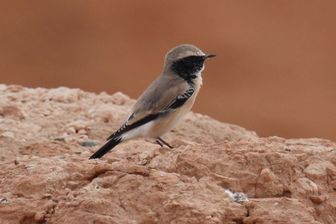Desert Wheatear
It is a migratory insectivorous species, 14.5 to 15 cm in length. Both western and eastern forms of the Desert Wheatear are rare vagrants to western Europe.

Original source: Alastair Rae from London, United KingdomOther versionsDerivative works of this file:
Author: Alastair Rae from London, United KingdomOther versionsDerivative works of this file:
The Desert Wheatear is classified as Least Concern. Does not qualify for a more at risk category. Widespread and abundant taxa are included in this category.
nana and desert wheatear Oenanthe deserti , while the flat gravel areas between the dunes is favoured by flocks of Black-crowned finch lark. Brown-necked ravens Corvus ruficollis are usually encountered in the sand desert areas, particularly inland from Umm al Quwain. Nearer the mountains, east of a line from Al Ain to Ras al-Khaimah, the sand dunes give way to a broad gravel plain scattered with Acacia tortilis . This savannah plain is relatively rich ornithologically, particularly as you approach the base of the mountains. More
This Desert Wheatear (Oenanthe deserti) is a bird that prefers arid land and this one landed on my ships deck when we were somewhere between the Oman and Pakistani coast. In the subcontinent the bird breeds in Pakistan and Kashmir and during winters it migrates to the south of India all the way until Sri Lanka. Hence the bird is sighted south of Kashmir mostly during winters.Eats insects loves to much on beetles Sony H-7 with 1.7x telephoto f/8, 1/200. More
The Desert Wheatear (Oenanthe deserti) is a wheatear, a small passerine bird that was formerly classed as a member of the Thrush family Turdidae, but is now more generally considered to be an Old World flycatcher, Muscicapidae. It is a migratory insectivorous species, 14.5 to 15 cm (5¾–6 inches) in length. Both western and eastern forms of the Desert Wheatear are rare vagrants to western Europe. More
Desert Wheatear is the most regular but it is far from common. All wheatears are birds of dry, open places but with subtle differences in habitat preference. The Desert, along with the Isabelline O. isabellina, favour dry sandy plains with minimal scrub and grass cover. The best place to see both of them is on the flats south of Sultanpur or the field south of Tughlaqabad Fort but they could turn up anywhere. More
Juvenile desert wheatear begging for food© Jean-Lou Zimmermann / Biosphoto Adult female desert wheatear perched on a small stone© Neil Bowman / www.flpa-images.co.uk Side view of an adult female desert wheatear© Neil Bowman / www.flpa-images.co.uk Front view of a male desert wheatear© Steve Young / www.flpa-images.co.uk Adult male desert wheatear© Markus Varesvuo / naturepl. More
Information on the desert wheatear is currently being researched and written and will appear here shortly. Environment Agency - Abu Dhabi is a principal sponsor of ARKive. EAD is working to protect and conserve the environment as well as promoting sustainable development in the Emirate of Abu Dhabi. Authentication - This information is awaiting authentication by a species expert, and will be updated as soon as possible. More
The western Desert Wheatear breeds in the Sahara and the northern Arabian peninsula. The eastern race is found in the semi-deserts of central Asia and in winter in India and northeast Africa. The upper parts of the male in summer are buff. The underparts are white with a buff tinge on the breast. The black on the face and throat extends to the shoulders, and there is distinct white superciliary stripe. More
Desert Wheatear determination Similar species Muscicapidae Black Redstart | Black Wheatear | Black-Eared Wheatear | Blue Rock Thrush | Bluethroat | Brown Flycatcher | Canary Islands Chat | Collared Flycatcher | Desert Wheatear | Finschs Wheatear | Isabelline Wheatear | Moussiers Redstart | Nightingale | Northern Wheatear | Pied Flycatcher | Pied Wheatear | More
Male Desert Wheatear at Irlam, Manchester, UK * * Add Video To Your Social Bookmarks Bookmark and Share Add comment - Something to say?.... More
For the purposes of our bird news services, Desert Wheatear is classed as Rare: species currently considered for acceptance by the British Birds Rarities Committee (or forms of equivalent rarity). More
Desert Wheatear, Kent, Dungeness 16/11/2003 © Martin Collins Leica 77 with handheld Coolpix 995 Desert Wheatear - Desert Wheatear, Kent, Dengemarsh Gully 16th Nov '03 © Marcus Lawson Desert Wheatear - Desert Wheatear, Kent, Denge Gully 16/11/03 © James Hunter Desert Wheatear - Desert Wheatear, Kent, Dengemarsh Gully 16-11-03 © andrew lawson Desert Wheatear - More
desert wheatear is more a bird of desert fringes rather than true desert and this may explain its apparent scarcity at Wadi Rum. Birds were recorded on 11 dates during the survey, usually singly, occasionally in pairs and on one occasion two males disputing a presumed territorial boundary. More
shelter for this Desert Wheatear, a major rarity in The Netherlands: it has only been recorded 8 times before, mainly in late autumn. Especially the month of November seems to be good to find this bird in W Europe. This record constituted the second spring record for our country. The first one, a female, was discovered by a biking birder near Oud-Alblas ZH on 24 April 1989. More
Desert Wheatear - Definition = Desert Wheatear Desert Wheatear Scientific classification Kingdom: Animalia Phylum: Chordata Class: Aves Order: Passeriformes Family: Muscicapidae Genus: Oenanthe Species: deserti Binomial name More
Desert Wheatear (Oenanthe deserti)1203 vuesrosarion * desert wheatear, horsey norfolk 2711070:23 * Ajouter à la file d'attente Ajoutée à la file d'attente desert wheatear, horsey norfolk 271107711 vueshammyhampson * Reed Warbler Singing at Simar, Malta0:46 * Ajouter à la file d'attente Ajoutée à la file d'attente More
Family : Muscicapidae
Genus : Oenanthe
Species : deserti
Authority : (Temminck, 1825)
